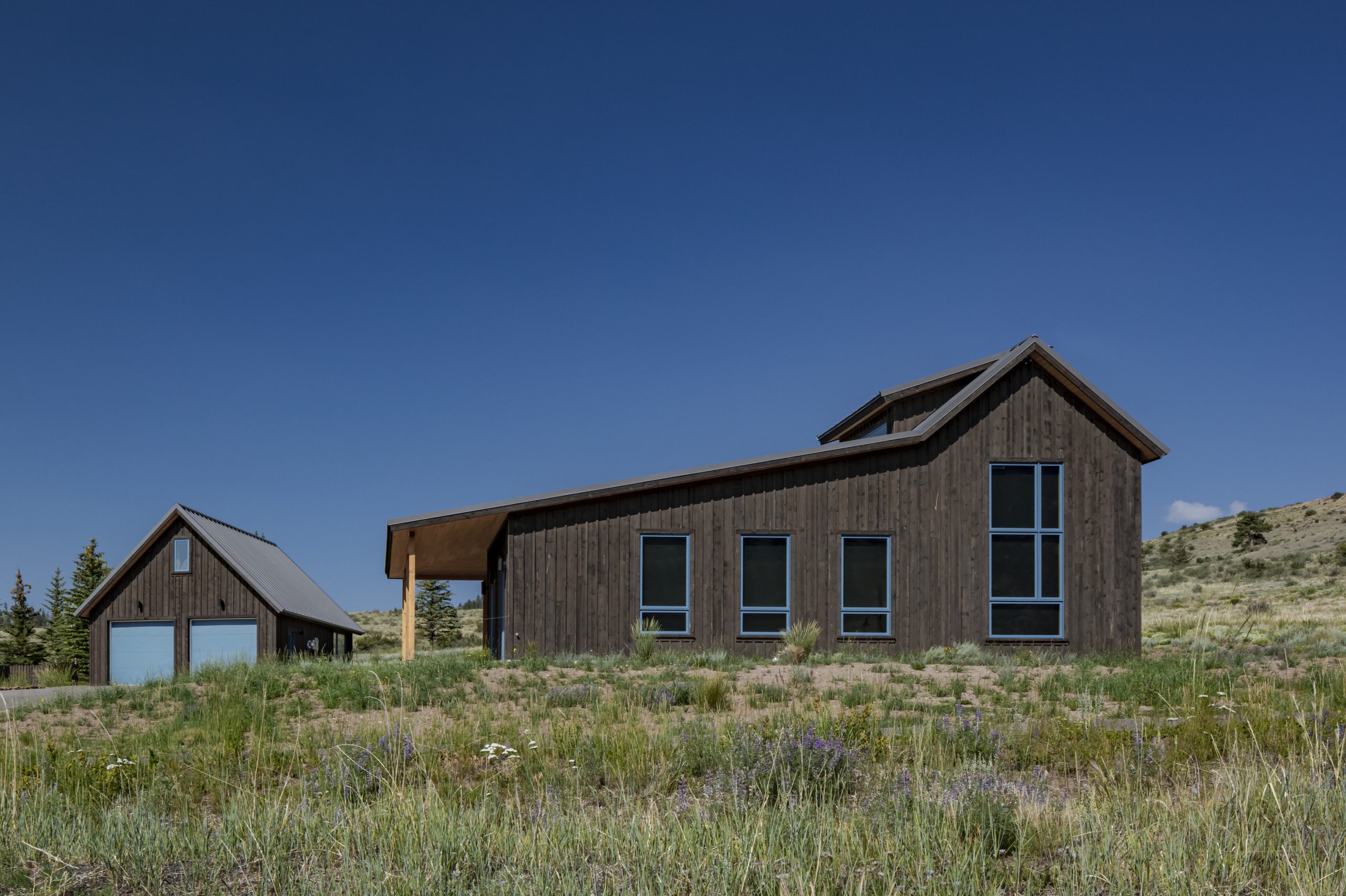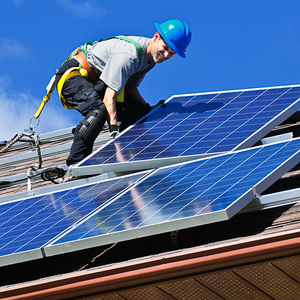
Editor’s Note: This is part of a series of posts describing the construction of a net-zero energy house in Rochester, Minnesota, by Tracee Vetting Wolf, Matt Vetting, and their son Max. You can find their complete blog here. A list of their previous posts appears at the bottom of this column.
Before starting our net-zero house, we rented a 2,165-square-foot house built in the late ’90’s.
The house has two levels, four bedrooms, and two bathrooms. The lower level of the house is one-half to three-quarters below ground, with the master bedroom and the kitchen on the upper level. A portion of the house, above the dining and living areas, has a 15-foot vaulted ceiling and no attic space, while the other half has lower ceilings and an insulated attic. Based on the thickness of the window wells, the walls appear to be constructed of 2×6 lumber, and we assume the bays are filled with fiberglass batts. The windows are a mix of fixed, sliding, and casement windows with double-pane glass, presumably pretty good windows for the 1990s.
The main heating for the home is forced air from a gas furnace supplemented in the lower level by a gas fireplace insert. The water is heated by a gas-fired water heater. Cooling is central air with an outdoor condensing unit. The clothes washer and dryer are both electric. There are two refrigerators and an electric stove. We have two desktop and two laptop computers, a modern flat-screen TV, and the house has a mixture of incandescent, LED, and compact fluorescent lights.
The house and water heating are the easiest to understand and calculate as we can just look at our gas bill.
We use the most gas, of course, in the dead of winter, approximately 180 therms in January, and the least in July—approximately 23 therms. From November 2016 to October 2017 we used a total of 801 therms of natural gas. Gas use in the middle of the summer would be entirely consumed by the water heater, so we can calculate our entire house heating load as 801–(23 x 12). So 276 therms to heat water and 525 therms to heat the house. One therm is approximately 100,000 Btu, so 27.6 million Btu to heat water and 52.5 million Btu to heat the house. The amount of energy to heat the water (276 therms) was almost exactly what is printed on the energy saver guide on the side of the water heater, 268 therms typical yearly usage.
Our electricity use varies from about 1000 kWh to 600 kWh per month and we are uncertain about why we have such a large variability. It could be that after March there was typically no one home during the day to use electricity. Also our desktop computers finally started to enter hibernation mode when not in use much more reliably so they were not spinning during the daytime or at night. We use very little air conditioning during the summer, generally just a few hours a week during the worst of the heat, mostly to remove the humidity, and as such there is not a large jump in our use during the summer.
From December of 2016 to November of 2017 we used about 9000 kWh of electricity for an average of 750 kWh per month. This will have to be reduced when we get in our new net-zero house as we expect to generate 12,100 kWh of electricity from our solar panels and will be generating domestic hot water and space heating with electricity.
Things that may help reduce our usage will be all new high efficiency electric appliances, one less fridge, all LED lighting, large shade-free windows, and the smaller footprint of the house. Since we will be monitoring our electric usage and trying to get to net zero we should be more vigilant with turning things off when not in use.
How efficient is the heating/insulation of our rental house? Based on Btu used per square foot per heating degree day (2017 HDD was 7343) the calculation is 52,500,000 Btu/2100 sq.ft./7343 = 3.43. That puts the house in the low end of energy use, a group that includes 12% of homes in this 1997 survey.
If you include hot water it would be 801,000,000 Btu/2100 sq. ft./7343 = 5.19. I include the hot water so I can compare this statistic to the value calculated for our previous house in New York State. It was a 1930s house with little to no insulation in the walls, single pane windows and an oil boiler. Domestic hot water came from the boiler, so water heat can’t be separated from space heating in this calculation.
We used approximately 950 gallons of #2 fuel oil per year (1 gallon = 138,500 BTU). Ossining, N.Y., on average has 5500 HDD so the calculation is 950 gallons x 138,500 Btu per gallon/1450 sq. ft./5500 HDD = 16.4. If you include the unfinished basement, which was passively heated through waste heat and passage of heat through uninsulated floor, then the square footage would increase 33% to 2175, and the Btu/sq. ft./HDD would drop to 11.0. Not as bad as I thought, but more than 50% of households had lower numbers in that 1997 survey.
The current PHIUS passive house standards for home heating is 7300 Btu/sq. ft./year for Climate Zone 6 (Rochester). So that would be a Btu/sq. ft./HDD for Rochester of 1. Can our net-zero house approach a heating efficiency rating of 1? I think it may be difficult unless we hit some super tight air exchange rates (<0.5 ach50) and get lots of passive gains (solar gains, people and pets, appliances).
Planning for solar in the new house
We positioned one of the long faces of our house approximately due south so that we could capture more sun on the solar panels that we plan on installing on the roof (also for passive solar gain, but that’s another post).
It’s a right-sized house, so it is not going to have an expansive roof, but it is a simple roof (no dormers, etc.) where most of the south-facing roof will be available for solar panels. The amount of energy we can get from the whole array will of course depend on how many panels we can fit on the roof, the potential wattage of each solar panel and the amount of sun we expect to get in southeastern Minnesota.
The roof is 56.7 feet long, including the 2-foot rake overhangs on the east and west sides. The roof has an 8/12 pitch. The width of the house is approximately 18 feet and there are 3-foot eves on the north and south sides. Doing the math, this means the width of the roof is 15 feet. So we have approximately 850 square feet of roof on which to mount solar panels.
Then there are three constricting factors for the number of panels which can be mounted.
- The dimensions of the solar panels. Solar Connection, our solar panel supplier and installer strongly suggested Solarworld Sunmodule XL as a good balance of quality and low cost. These panels are a little bigger (78.5 inches x 39.4 inches) than most other standard solar panels, which are 65 inches by 39 inches.
- We want to mount panels in portrait mode which therefore limits the number of rows of panels. The extra height of the Solarworld panels helps in using more of the roof surface. With either the Solarworld panel or standard solar panels we could only fit two rows on the roof.
- Building restrictions which require two access paths from the eve to the ridge for firefighter access. Two 3-foot paths are required.
Placing the panels side by side in two rows of 15 panels for a total of 30 panels with firefighter access on the east and north ends (as shown in drawing above).
How much energy will the panels produce?
The amount of energy we can expect from these panels depends on their rated capacity (potential output) and the amount of sunshine we get in southeastern Minnesota.
Typical output ranges from 200 to 350 watts, which is a function of how efficiently the modules convert solar energy into electricity, and the dimensions of the panel. Since we are somewhat restricted in the amount of space, we are choosing a panel with a higher wattage per panel so we can maximize output. Other homeowners may choose a panel with less wattage if they have more space and/or lower energy requirements as they are less expensive than the high wattage panels. The bid for our solar panels uses Solarworlds Sunmodule XL at 350 watts per panel.
To calculate the size of our array we multiply the wattage of the solar panels by the number of solar panels (350 watts x 30 panels) resulting in a 10.5 kW array. How much electricity can we expect from a 10.5 kW array? There are a number of web based calculators to do such a calculation. Here we will just plug in the numbers and use data from the National Renewable Energy Laboratory.
A 10.5 kW array is the starting point. Day length and orientation in the sky matters, so one has to look at a solar map to determine how much solar energy a particular location receives. Rochester, Minnesota, on a yearly average receives 4 to 4.5 kWh/m2/day so to calculate the output we multiple our array size (10.5 kW) by the amount of solar energy Rochester receives (we will be conservative and say 4 kWh/m2/day) and then multiply that by the number of days (365). So our solar power array has the potential to produce 15,120 kWh per year (10.5 x 4 x 365). However, there are typically various losses due to temperature, wiring, and inverter efficiency which means you only can harvest about 80% of the panel output—so now it’s down to 12,096 kWh.
[Note: Another way of estimating the electrical output of a solar array is by using the PVWatts Calculator developed by NREL.]
Bottom line, we can fit thirty panels and if those panels are 350 watt panels they will hopefully produce approximately 12,100 kWh of electricity. Now we just have to see if this will be enough electricity to meet all of our energy needs.
UPDATE: Our solar contractor indicated that firefighter access strips can be as small as 1 foot wide so technically we could add an additional column of panels to up the total to 32. In addition we would probably want to center the array vertically on the roof as Minnesota regulation specifies the solar panels can not exceed the height of the ridge line.
Other posts about the Minnesota Homestead:
Why We Built an Energy-Efficient Home
Weekly Newsletter
Get building science and energy efficiency advice, plus special offers, in your inbox.















13 Comments
> Now we just have to see if this will be enough electricity to meet all of our energy needs.
I guarantee that it won't - you will "borrow" significant energy from the grid. Paying it back within a year doesn't balance out - it has negative environmental and cost implications.
You can expand that out to take into account how the grid power is generated, or keep going examining their choices of transportation, whether they should have decided to build a new house, decide to have children and pets - or even stay on the planet at all.
Or you could take the statement at face value. Will their PV generation match their electric consumption over the year? I'd kind of vote for that approach.
Sure, there is a question of where do you stop. But here's an example pretty much limited to building design and yet, IMO, comes up with the wrong answer:
Design A has more solar panels (and relies on net metering)
Design B has more insulation
Design A is selected because it is slightly more cost effective for the homeowner. But Design B is better for the environment and is lower cost to society as a whole. A faulty metric is distorting the design process.
My proposed solution: regulators set electricity prices (buy and sell with time of use adjustments) to more accurately account for everything (including externalities like environmental damage). Then "whatever's lowest cost to the homeowner" would more accurately match what's best for everyone.
Jon,
That sounds like a good solution, although I don't understand enough about the issue to make any informed judgement.
However, in the absence of your scheme being implemented, and given that we can only work with the net-metering arrangements our utility presently offers, I don't see how you can criticize anyone for sizing their PV array to equal what they consume.
In the meantime - at least take a stab at estimating the externalities beyond the poor "net consumption per year sums to zero". This should prevent things like XPS and electric water heaters without timers.
I'm seeing some rather erratic humidity and temp readings at their house. Not something I would've expected.
http://vettingwolfhomestead.com/current-conditions/
Without AC, that is what I would expect.
That's right.
Also note that the relative humidity is changing in inverse response to the air temperature, which is also to be expected. Even when there is no change in the moisture levels RH alwasy goes up as the temperature goes down, and conversely. The RH peaks are coincident with the temperature lows, and the RH lows are coincident with the temperature peaks. To know how much the humidity is changing would require converting to wet-bulb temperature or dew point temperature, either of which would not be varying NEARLY as much as the simple relative humidity.
I guess. For some reason I thought the R-value was higher because they used 2x6 w/exterior foam. However it appears they went with 2x4 + OcSPF instead.
400 watt panels available if you want to increase the total solar output.
>"In the meantime - at least take a stab at estimating the externalities beyond "net consumption per year sums to zero". This should prevent things like XPS and electric water heaters without timers."
The externalities are a moving target, with a rapidly greening grid (in most areas). The error bars on lifecycle externalities are pretty wide over the anticipated lifecycle of a house.
Timers on electric water heaters aren't nearly as important as "grid aware" systems that would allow a utility or third party aggregators to use the electric water heater for voltage and frequency control purposes. A Wi-Fi electric water heater can be used that way, but there are also retrofit solutions. When the local mix of variable output renewables gets well into double-digits it's useful to have controllable loads as an energy dumps for providing those grid services. A smart EV charger with an electric car plugged into it can be used that way, but using electric water heaters as "grid batteries" is a lot cheaper up front.
Timers are nearly useless, since the daily peaks and valleys of the grid load vary with the weather, and where there is a surplus of wind & solar generation the daily peaks in generation are becoming less consistent day to day too.
The area of solar panels was limited by requiring "two access paths from the eve to the ridge for firefighter access."
How pointless. Anyone that decided to walk your roof during a fire is an idiot.
How much snow will be sitting on your panels in winter? Are you putting snow stops on your roof to stop a heavy snow load from suddenly giving way?
Log in or create an account to post a comment.
Sign up Log in